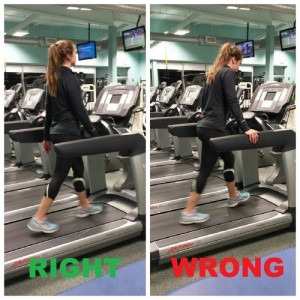THE TREADMILL- WE WALK, WE RUN, WE JOG, AND WE CLIMB HILLS. IT IS A FAIRLY SIMPLE PIECE OF EXERCISE EQUIPMENT; BUT KNOWING HOW TO PROPERLY USE A TREADMILL WILL HELP YOU GET THE MOST BENEFIT FROM YOUR EXERCISE AND AVOID INJURY.
How about form?
Walking or running on the treadmill should match the way you would walk on the ground. People frequently alter their gait when on the treadmill. Posture and stride length are two things affected. You should walk with your head and chest up, keeping your core tight, and shoulders back. Think of a nice, tall posture; not hunched over or looking at your feet. If you keep your arms relaxed, they should swing naturally at your side. Try to avoid shortening or adjusting your stride and focus on a natural movement.
What about the handrails?
Holding onto the handrails affects the quality of your exercise. ACSM notes that holding onto the handrails results in an inconsistent walking pace. This creates an unnatural form which may results in muscle strain or discomfort.
Additionally, holding the handles will basically make your workout easier. The amount of effort required is reduced, this reducing the number of calories expended during your exercise bout. Two offenses can be made here- holding onto the side handles and holding onto the one in front.
Offense #1
 Holding onto the side bars allows you to support your body weight while you walk. The load is transferred from your legs to your upper body which reduces the amount of effort it is taking to walk. Your cardiorespiratory system does not have to work as hard to move your body with the extra support. Holding on this way makes it easier on your body; less work = less calories expended.
Holding onto the side bars allows you to support your body weight while you walk. The load is transferred from your legs to your upper body which reduces the amount of effort it is taking to walk. Your cardiorespiratory system does not have to work as hard to move your body with the extra support. Holding on this way makes it easier on your body; less work = less calories expended.
Offense #2
 Holding onto the handle right in front of you is a common offense as well, especially when you are walking at an incline. Walking or running up an incline forces you to shift your body weight forward and push yourself up that hill. By holding on to the treadmill, you allow yourself to lean back by extending your back and arms. The purpose of walking up that hill for the extra challenge is negated by leaning back. Shifting your weight forward while walking/running up that incline keeps your body upright, working your core and postural muscles.
Holding onto the handle right in front of you is a common offense as well, especially when you are walking at an incline. Walking or running up an incline forces you to shift your body weight forward and push yourself up that hill. By holding on to the treadmill, you allow yourself to lean back by extending your back and arms. The purpose of walking up that hill for the extra challenge is negated by leaning back. Shifting your weight forward while walking/running up that incline keeps your body upright, working your core and postural muscles.
Balance
Balance improvements will not come from hanging on to the treadmill for stability. Holding on trains your body to rely on the extra support. Letting go can help you improve your balance and allow you to have a natural gait.
Considerations
Of course, there is an exception to the rule. If you are just starting out using a treadmill, then holding onto the handrails until you are accustomed to the movement. Once you become comfortable walking, try using only one hand for support then transition to letting your arms swing naturally.
If you have any issues with coordination or balance, then utilize the handrails for a little support. Try holding on with a light touch by placing your hands on top of the handrails. If you feel unsteady, you can then hold on, but you won’t put the pressure on your upper body.
For additional information, please refer to ACSM’s treadmill guide.
http://www.acsm.org/docs/brochures/selecting-and-effectively-using-a-home-treadmill.pdf?sfvrsn=2

